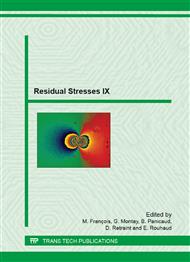[1]
S. M. Afazov, A. A. Becker, T. H. Hyde, Effects of Micro-Stresses from Machining and Shot-Peening Processes on Fatigue Life, Int J Adv Manuf Technol 51 (2010) 711-722.
DOI: 10.1007/s00170-010-2638-y
Google Scholar
[2]
M. J. Leap, J. Rankin, J. Harrison, et al., Effects of Laser Peening on Fatigue Life in an Arrestment Hook Shank Application for Naval Aircraft, PHM 2011Montreal (Canada) (2011).
DOI: 10.1109/icphm.2011.6024336
Google Scholar
[3]
S. Tiitto, On the influence of microstructure on magnetization transition in steel, Acta Pol. Scand. 119 (1977) 1-80.
Google Scholar
[4]
J. B. Goodenough, A Theory of Domain Creation and Coercive Force in Polycrystalline Ferromagnetics, Phys. Rev. 95 (1954) 917-932.
DOI: 10.1103/physrev.95.917
Google Scholar
[5]
V. Moorthy, B. A. Shaw, Magnetic Barkhausen Emission Measurements for Evaluation of Material Properties in Gears, NDT&E INT 23 (2008) 317-347.
DOI: 10.1080/10589750802275980
Google Scholar
[6]
B. A. Shaw, T.R. Hyde, J. T. Evans, Detection of Grinding Damage in Hardened Gear Steels using Barkhausen Noise Analysis, ICBM 1 Hanover (Germany) (1998).
Google Scholar
[7]
S. Santa-Aho, M. Vippola, T. Saarinen et al, Barkhausen Noise Characterisation during Elastic Bending and Tensile-Compression Loading of Case-Hardened and Tempered Samples, J. Mater. Sci. 47 (2012) 6420-6428.
DOI: 10.1007/s10853-012-6571-3
Google Scholar
[8]
S. Desvaux, M. Duquennoy, J. Gualandri, M. Ouaftouh, M. Ourak, Evaluation of residual stress profiles using the Barkhausen noise effect to verify high performance aerospace bearings, NDT&E INT (2005) 20 9-24.
DOI: 10.1080/10589750412331315093
Google Scholar
[9]
O. Kypris, I. C. Nlebedim, D. C. Jiles, Mapping Stress as a Function of Depth at the Surface of Steel Structures using a Frequency Dependent Magnetic Barkhausen Noise Technique, IEEE Trans. Magn. 48 (2012) 4428-4431.
DOI: 10.1109/tmag.2012.2196792
Google Scholar
[10]
J. S. Ceurter, S. Chad, O. Roy, The Barkhausen noise inspection method for detecting grinding damage in gears, ICBM 2 Newcastle (UK) (1999).
Google Scholar
[11]
T. Inaguma, H. Sakamoto, M. Hasegawa, Stress Dependence of Barkhausen Noise in Spheroidized Cementite Carbon Steel, IEEE Trans. Magn. 49 (2013) 1310-1317.
DOI: 10.1109/tmag.2012.2220856
Google Scholar
[12]
V. Moorthy, B. A. Shaw, J. T. Evans, Evaluation of Tempering Induced Changes in the Hardness Profile of Case-Carburised EN36 Steel using Magnetic Barkhausen Noise Analysis, Trans. Magn. 36 (2003) 43-49.
DOI: 10.1016/s0963-8695(02)00070-1
Google Scholar
[13]
Electrolytic Polishing, in: Metallography and Microstructures, ASM International, 1995, pp.48-56.
Google Scholar
[14]
M.G. Moore, W.P. Evans, Mathematical correction for stress in removed layers in X-ray diffraction RS analysis, SAE Trans. 66 (1958) 340–345.
DOI: 10.4271/580035
Google Scholar
[15]
M. Soto, A. Martínez-de Guerenu, K. Gurruchaga, F. Arizti, A completely configurable digital system for simultaneous measurements of hysteresis loops and Barkhausen noise, IEEE T Instrum Meas 58 (2009) 1746-1755.
DOI: 10.1109/tim.2009.2014510
Google Scholar
[16]
D. C. Jiles, Introduction to magnetism and magnetic materials, second ed., Chapman & Hall, Boca Raton, (1998).
Google Scholar


